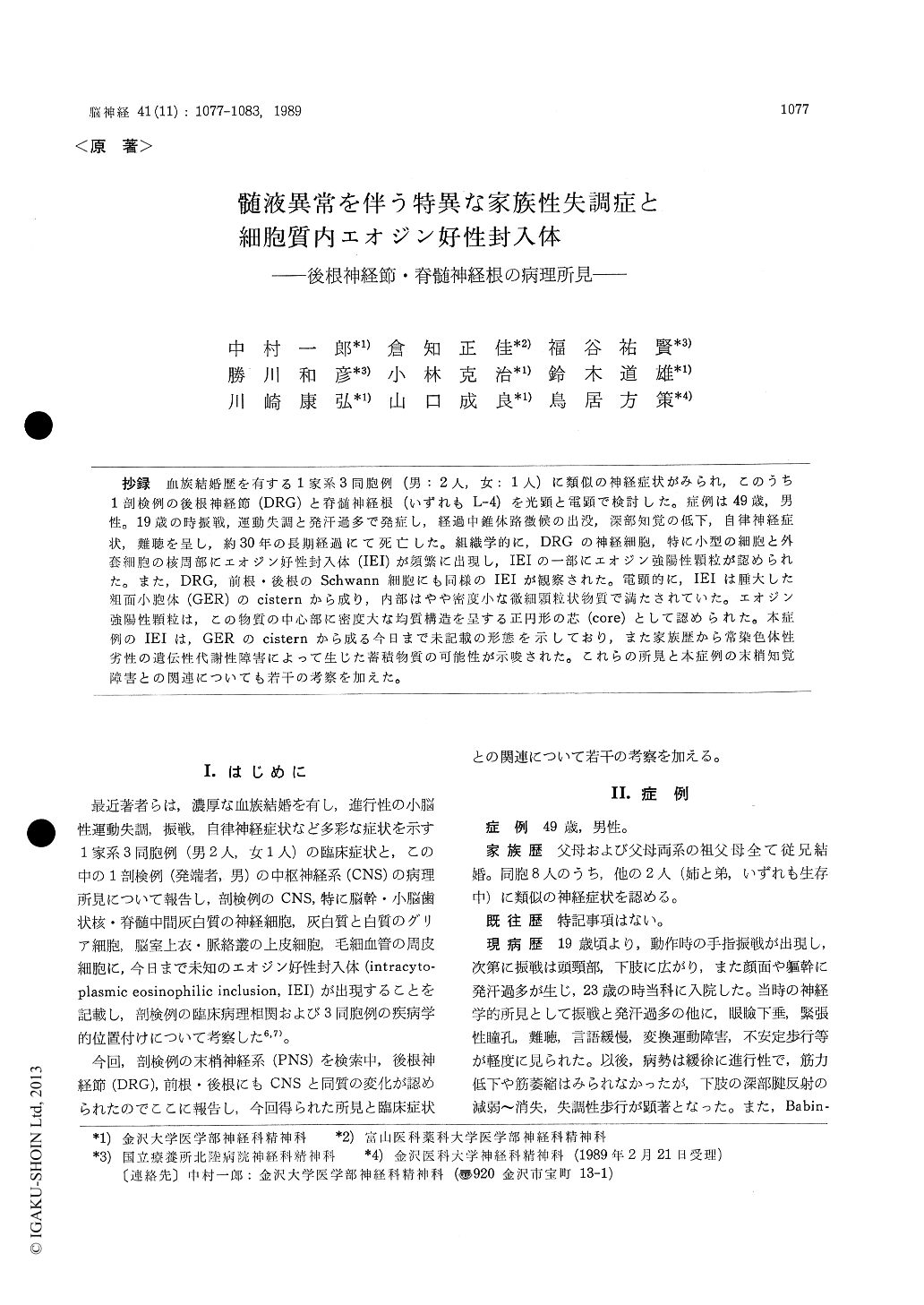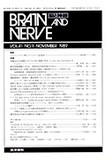Japanese
English
- 有料閲覧
- Abstract 文献概要
- 1ページ目 Look Inside
抄録 血族結婚歴を有する1家系3同胞例(男:2人,女:1人)に類似の神経症状がみられ,このうち1剖検例の後根神経節(DRG)と脊髄神経根(いずれもL−4)を光顕と電顕で検討した。症例は49歳,男性。19歳の時振戦,運動失調と発汗過多で発症し,経過中錐体路徴候の出没,深部知覚の低下,自律神経症状,難聴を呈し,約30年の長期経過にて死亡した。組織学的に,DRGの神経細胞,特に小型の細胞と外套細胞の核周部にエオジン好性封入体(IEI)が頻繁に出現し,IEIの一部にエオジン強陽性顆粒が認められた。また,DRG,前根・後根のSchwann細胞にも同様のIEIが観察された。電顕的に,IEIは腫大した粗面小胞体(GER)のcisternから成り,内部はやや密度小な微細顆粒状物質で満たされていた。エオジン強陽性顆粒は,この物質の中心部に密度大な均質構造を呈する正円形の芯(core)として認められた。本症例のIEIは,GERのcisternから成る今日まで未記載の形態を示しており,また家族歴から常染色体性劣性の遺伝性代謝性障害によって生じた蓄積物質の可能性が示唆された。これらの所見と本症例の末梢知覚障害との関連についても若干の考察を加えた。
Studies were performed on the light and electron microscopic structures of the dorsal root ganglia (DRG) and spinal nerve roots of the 4th lumber nerve obtained by autopsy from a 49-year-old man with unusual familial ataxia, who showed varied neurological manifestations such as progressive ataxia, action tremors, pyramidal tract signs, mild deep sensory disturbances and autonomic dysfunc-tions during a 30-year period of illness, and had 2 siblings, one male and female, similarly affected and close consanguineous marriages in his family. On laboratory examinations, blood chemistry dis-closed no significant findings. Repeated spinal taps showed constant xanthochromia and elevated protein in the cerebrospinal fluids. A PEG and cranial CTs revealed a progressive brain atro-phy. NCVs and EMGs in the extremities were within normal limits. There was no chromosomal abnormality.
Light microscopically, intracytoplasmic eosino-philic inclusions (IEIs) with pale rim, which showed varied sizes and rounded shapes, occurred within neurons in the DRG, particularly in small neurons. Many of the small neurons had numer-ous IEIs, and several rounded granules with a high degree of eosinophilia, measuring below 5 pm in diameter. Generally the small neurons showed atrophic, while most large neurons showed no re-markable change although they had a small number of IEIs and granules located in the perikaryal periphery. Most satellite cells, and some Schwann cells in the DRG, ventral and dorsal roots had IEIs similar to those seen in the neurons. No IEIs occurred intraaxonally, and there was seen no degenerative process in the DRG and roots except a connective tissue fiber proliferation in the DRG.
Electron microscopically, the IEIs in neurons were shown as a less dense, fine granular material with a single membrane attached to ribosomes, and the granules as a dense rounded, homogeneous core surrounded with the materials. There were a large number of free ribosomes in the cytoplasm between IEIs. In many small neurons IEIs were densely distributed in the major part of perikaryon, while in large neurons they were located in the perikaryal periphery. Electron-dense, rounded hom-ogeneous bodies often appeared in the perikaryon of the large neurons, but they could be diffe-rentiated from the dense cores with the materials and identified as a mitochondrial inclusion body. IEIs in satellite cells were similar to those in neu-rons, but the former was more larger in size and irregular in shape than the latter, while the dense cores of the former were more smaller in size and multiple in number than the latter. The satellite cell nuclei were often deformed concave because of the presence of IEIs adjacent to them. IEIs in Schwann cells surrounding myelinated nerve fibers were identical to those in the satellite cells.
According to the present study, there is a dis-crepancy between the degrees of the sensory dis-turbances and pathological findings. The neurons within the DRG may not so much functionally deteriorate even though they have many IEIs. It is suggested that the IEIs in the cells above mentioned are derived from distended cisterns of the granular endoplasmic reticulum (GER), and that they represent material storage arising from a genetically determined GER dysfunction in pro-tein synthesis. The case is far different from vari-ous neuronal storage diseases previously reported.

Copyright © 1989, Igaku-Shoin Ltd. All rights reserved.


